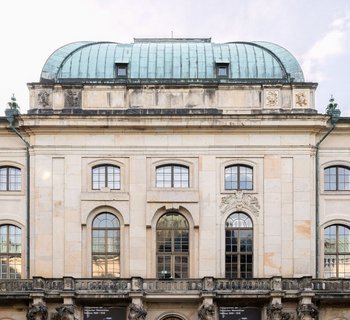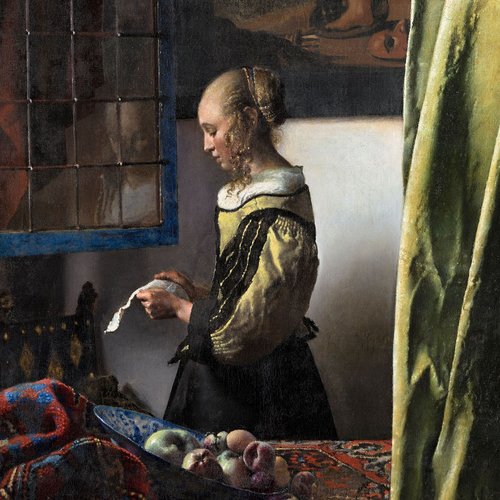
Experience the new tactile model of the Japanisches Palais (Japanese Palace)!
The impressive museum building awaits you here as a pink tactile model with relief and Braille lettering in German and English on a scale of 1:150. The scaled-down replica of the Japanisches Palais allows you to experience the architecture and details of this historic building in a variety of ways.
The model, which measures 49 cm by 47 cm, was created using state-of-the-art technology. A surveying company scanned the Japanisches Palais with a drone to create a digital file. This was then used to produce the model using a 3D printing process. Although some of the finest details cannot be experienced due to the reduction in size, this tactile model still offers an impressive opportunity to familiarise yourself with the structure of the palace.
The tactile model is placed on a plate with the name of the building at the top right. Below this, on the right-hand side, are the logo of the Staatlichen Kunstsammlungen Dresden, the logo of the Federal Government Commissioner for Culture and the Media and two tactile QR codes, the left-hand one leading to the German audio description and the right-hand one to the English audio description. On the lower or front side, from left to right, there is a compass rose, the scale, an entry mark with arrow and a scale bar. The word "Elbe" is located in the top or rear left-hand corner.
While you embark on a tactile journey of discovery, we would like to give you some exciting insights into the history of the Japanisches Palais. In addition to the tactile model, you can listen to a 6-minute audio description in German or English. You can access this on this page or via the QR codes on the tactile model.
Audio file tactile model
Audio file tactile model with breaks
Das Japanische Palais
The Japanische Palais (Japanese Palace) was built in the 18th century in the Dresden Baroque style and played an important role in the collection of Augustus the Strong, who used it as an exhibition venue for his valuable porcelain collection. The architecture of the palace is a fascinating mixture of East Asian influences and the European Baroque style of the royal houses of the time. The architectural elements reflect Augustus' claims to power and his fondness for Meissen porcelain. The hierarchy and perception of East Asia in a European context is made clear by the palace's architecture and ornate sculptures.
We cordially invite you to explore this tactile model in the foyer of the Japanisches Palais and learn more about the history and fascinating architecture of the building.
Standort:
Location: Japanisches Palais, foyer on the ground floor
Admission: free
Accessibility: uneven floor (large, coarse sandstone slabs), can be reached without stairs, labelling in relief and Braille as well as in German and English, audio description in German and English available via QR code or website with smartphone or tablet, blindFind acoustic guidance system for blind people and people with visual impairments, WiFi available, no wheelchair-accessible toilets, no passenger lift, exhibitions on the 1st floor can only be reached via stairs.
Audio description of the Tactile Model Japanisches Palais
Welcome to the Japanisches Palais, the Japanese Palace. On the pedestal in front of you sits a model of the Japanisches Palais on a scale of 1:150. You can find some information printed in relief and Braille on the model’s base plate. Ideally, you position yourself so that the QR codes are in the lower right corner. Then, the title “Japanisches Palais” is on the upper right, below are the logo and the reference to the sponsor of the tactile model and on the lower right are the QR codes. On the upper left, the direction to the river Elbe is shown. On the lower edge, from left to right, you find a compass dial, the indication of the model’s scale as well as a scale bar representing 20 meters. Right in front of the model, the entrance is labelled and marked with a triangle indicating the direction.
The Japanisches Palais is a rectangular four-wing building of sandstone with a large inner courtyard. It has three storeys, and each storey has a matching set of windows at each side. The middle of the building is especially highlighted with magnificently designed portals on the front and back side. The building’s corner areas are equally highlighted by the implication of square towers. The roof of green oxidised copper plates forms rising domes above the portals. The corner towers are crowned with curved two-level pagoda roofs. This is a common roof shape in Asian architecture that, thus, gives the palace its seemingly Asian appearance. In the courtyard, above the ground floor, a gallery runs along the short sides on the right and left as well as the long back side - the side of the river Elbe. This gallery, which is not accessible for visitors, is carried by pillar figures, the so-called Japanese herms, which we will describe later.
The Japanisches Palais was constructed in the 18th century in Dresden Baroque style and was acquired by Augustus the Strong in 1717 to accommodate his porcelain collection. He planned to present the most precious Japanese pieces in the entrance area. The palace was, thus, called Japanisches Palais. Augustus the Strong had the building thoroughly reconstructed. Its new architecture was characterized by the Chinese inspired architectural style and its light-flooded construction. At the same time, clear similarities with the Louvre in Paris are recognizable, especially in the design of the entrance portal. With this magnificent building, Augustus the Strong wanted to emphasize his position as Elector of Saxony and King of Poland.
In addition, the building can be conceived as a claim of what Augustus the Strong thought of himself, Europe and East Asia. Europeans had always cherished great fascination for East Asian porcelain. As they were unable to produce this material themselves, it was imported until the porcelain production was accomplished in Meissen. Augustus the Strong especially promoted the country’s own porcelain. Finally, when Meissen Porcelain was more appreciated in Europe than the East Asian one, Augustus displayed his triumph. He had this development and his claimed supremacy over East Asia incorporated into the architecture of the Japanisches Palais.
The entrance portal on the front side with its porch of six Roman pillars, a balustrade and a triangular gable was to attune people to this claim. In its centre, the relief in the triangular gable shows Saxonia as the impersonation of Saxony and ruler surrounded by groups of people with presents of porcelain on both sides. On the left, stereotyped East Asian people are packing their products for the return transport. On the right, stylized European people are triumphing, because they have been able to present their products - Meissen Porcelain - successfully. Two magnificent allegoric statues are enthroned above the triangular gable, Asia on the left and Europa on the right.
In the courtyard, the claimed power relationship between Europe and East Asia is taken up again. The 24 pillar figures, the Japanese herms, are clearly depicted in a derogatory way. This is already shown by the fact that they are carrying the first floor, as the Meissen Porcelain was exhibited there, while the East Asian porcelain artworks were kept on the ground floor.
Now, we are going to describe one of these Japanese herms in detail. It is a male figure around two meters beneath the gallery, worked out of the stone of a pillar from the hip upwards. A leg covered with fabric that he seems to cross over the other one is just implied. His top is open at the front, so that we can see a plumpish belly and dangling breasts. His right hand stretches up and supports the pillar’s end, which he carries on the back of his neck. Although the man is lifting so much weight, his body seems limp, which was to express the claimed inferiority of East Asian people. He is wearing a pointed hat and has a long moustache. He looks down to the visitor with his slanted eyes and his mouth is open in laughter. At the time, depicting persons laughing was to indicate a weak intellect. The other Japanese herms are depicted in a similar way. They wear pointed hats, have beards, are lightly dressed, and with limp posture.
Altogether, the negative depiction of East Asian people is very stereotypical, which may be a result of the fact that master builders of the time had hardly ever seen Asian people with their own eyes. Of course, neither in the past nor today would Asian people recognize themselves in these depictions.
And now we wish you a good time exploring this building!
The 3D tactile model of the Japanisches Palais was sponsored by the German Federal Government Commissioner for Culture and the Media.
